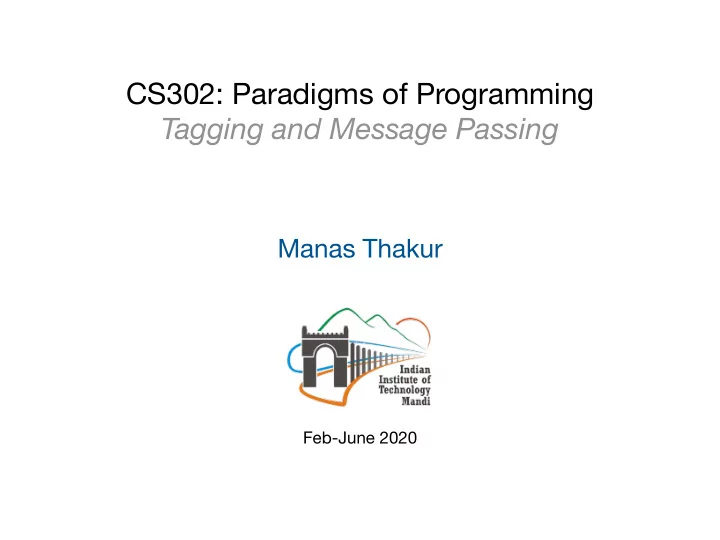

CS302: Paradigms of Programming Tagging and Message Passing Manas Thakur Feb-June 2020
Recall the problem we discussed in the last class • We had two representations for complex numbers (rectangular and polar). • Each representation seemed more natural for certain operations (rectangular for addition/subtraction, and polar for multiplication/division). • But name-conflict issues in our scheme forced only one to be used at a time. • Can we use both the representations together? 2
Tagging • Our problem is that both rectangular and polar complex numbers may be roaming around in an indistinguishable manner. • Further, the procedure names for the di ff erent representations are the same. • Easy solution: Rename the procedures: su ffi x ‘ -rectangular ’ with rectangular procedures and ‘ -polar ’ with polar procedures. • Let us introduce a mechanism to distinguish rectangular and polar representations of complex numbers. • Tag data items: • Rectangular data with ‘rectangular • Polar data with ‘polar 3
Attaching tags • How do we add a tag to a complex number? • cons the tag with the existing pair! (define (attach-tag type-tag contents) (cons type-tag contents)) (define (type-tag datum) (car datum)) (define (contents datum) (cdr datum)) • How could we find if a given complex number representation is rectangular or polar? (define (rectangular? z) (eq? (type-tag z) ‘rectangular)) (define (polar? z) (eq? (type-tag z) ‘polar)) 4
Revised rectangular implementation • Tags attached in the constructors: • Name conflicts resolved by renaming: 5
Similarly, the revised polar representation 6
Tagging solves the problem • Now we can decide which procedure to call using tags: • Basically, we are dispatching a procedure based on the type - tag associated with the data object . • Similar changes can be made for other conflicting procedures. • Both representations can co-exist peacefully. 7
Abstractions in our complex number library 8
Is there anything bad in our scheme? • What if I want to add 10 more representations? • Define new make-* procedures and selectors while making sure that the names don’t match — umm, painful but obvious. • Define a new tag for each representation — looks fine. • What about the generic procedures? • Need to add a case for each representation in each generic procedure — ouch! 9
Panacea for all but COVID-19: Message passing • Instead of making operations intelligent (using conditions), make the data objects intelligent (using conditions!): • What does make-from-real-imag return? • A procedure that takes an argument ‘ op ’ to decide what computation to perform. Picture abhi baaki hai! • And why is it so interesting? 10
Message passing (Cont.) • Let us change the generic procedures as follows: where: (define (apply-generic op arg) (arg op)) • Thus, our make-* procedure returns another procedure representing an object that dispatches the correct procedure based on the message passed to the receiver object. 11
Putting it all together (define (apply-generic op arg) (arg op)) (define (add-complex z1 z2) (make-from-real-imag (+ (real-part z1) (real-part z2)) (+ (imag-part z1) (imag-part z2)))) (define n1 (make-from-real-imag 2 3)) (define n2 (make-from-real-imag 3 4)) (define n3 (add-complex n1 n2)) 12
Back to Object-Oriented Programming • Read any standard textbook on Java/C++/C#/Python/your- favourite-OO-language: • Each OOL provides a mechanism to abstract objects belonging to a certain kind, such that: • the object encapsulates constituent data items as fields • and the procedures to operate on objects as methods • You create objects and assign values to its fields using constructors, and dispatch methods by passing messages to the receiver. 13
(define (make-rat x y) (lambda (which) (if (= which 0) x y))) (define (numer n) (n 0)) Abra-ca-dabra! (define (denom n) (n 1)) (define (mult-rat n1 n2) (make-rat (* (numer n1) (numer n2)) (* (denom n1) (denom n2)))) (define n1 (make-rat 2 3)) (define n2 (make-rat 3 4)) (define n3 (mult-rat n1 n2)) (define (Rational x y) (lambda (msg) (cond ((eq? msg ‘numer) x) ((eq? msg ‘denom) y) ((eq? msg ‘mult-rat) (lambda (other) (Rational (* x (other ‘numer)) (* y (other ‘denom)))))))) (define n1 (Rational 2 3)) (define n2 (Rational 3 4)) (define n3 ((n1 ‘mult-rat) n2)) 14
Now ain’t they similar? (define (Rational x y) (lambda (msg) Recall Slide 7; (cond ((eq? msg ‘numer) x) we got both: ((eq? msg ‘denom) y) • Packaging ((eq? msg ‘mult-rat) (lambda (other) • Dispatch (Rational (* x (other ‘numer)) (* y (other ‘denom)))))))) class Rational { // Plain syntactic sugar! (define n1 (Rational 2 3)) int x; int y; (define n2 (Rational 3 4)) Rational(int x, int y) { (define n3 ((n1 ‘mult-rat) n2)) this.x = x; this.y = y; } int numer() { return x; } int denom() { return y; } • Preserve this class to Rational mult-rat(Rational other) { return new Rational( understand the crux of this.numer() * other.numer(), some of the fundamentals this.denom() * other.denom()); } of the OO paradigm . } Rational n1 = new Rational(2,3); Rational n2 = new Rational(3,4); Rational n3 = n1.mult-rat(n2); 15
There’s more to OOP , though • The fields of an object encapsulate state, which keeps changing with time. • We have seen how to model objects, but … • not how to model state and change, yet. • Next class onwards: • Imperative programming, where “change will be the only constant” 16
Recommend
More recommend